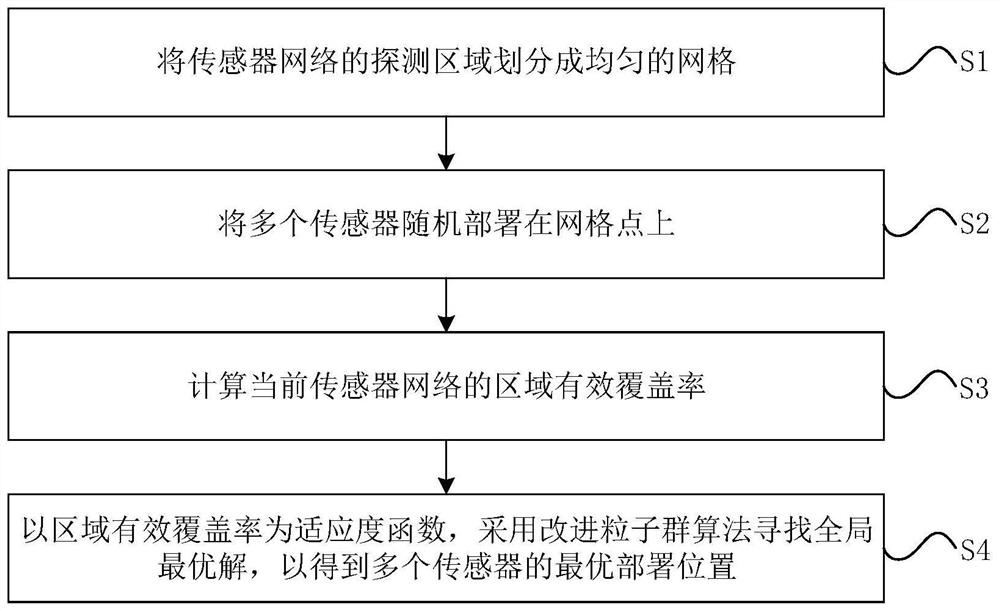Multi-sensor network collaborative deployment method and device based on improved particle swarm optimization
A technology for improving particle swarm and sensor networks, which is applied in specific environment-based services, network planning, wireless communication, etc. It can solve the problems of slow particle convergence and easy to fall into local optimum, and achieve a balance between global search ability and local improvement ability , Improve the effective coverage and expand the effect of coverage
- Summary
- Abstract
- Description
- Claims
- Application Information
AI Technical Summary
Problems solved by technology
Method used
Image
Examples
Embodiment 1
[0056] See figure 1 , figure 1 It is a schematic flowchart of a multi-sensor network collaborative deployment method based on an improved particle swarm algorithm provided by an embodiment of the present invention, including the following steps:
[0057] S1: Divide the detection area of the sensor network into a uniform grid.
[0058] In this embodiment, it is not appropriate to divide the grid too much, too much will lead to too much calculation of the algorithm, and too few divisions, the sensor moves too much each time the deployment position is moved, and it is difficult to find the optimal deployment position. In order to balance the relationship between the improvement degree of the algorithm coverage and the computational complexity of the coverage, this embodiment is preferably divided according to the sensing radius of the sensor. Specifically, in the detection area of the sensor network, the sensing radius of each sensor is evenly divided into 10 parts, and the...
Embodiment 2
[0101] In the following, the improved particle algorithm provided by the present invention is compared with the traditional random deployment algorithm and the existing standard particle algorithm through simulation experiments, so as to compare and illustrate the beneficial effects of the present invention.
[0102] 1. Test conditions:
[0103] Random deployment experiment: It is assumed that 3 static sensors are randomly distributed in the surveillance area [100km×100km]. All sensors have the same sensing radius r s =50km. The parameter of the sensor's uncertainty sensing range is δ=0.6, and the parameter of the probability measurement model is λ 1 =1, λ 2 =0.6, β 1 =3, β 2 = 2. The threshold perception probability of being able to detect the target is defined as 0.5, and 100 Monte Carlo experiments are carried out.
[0104] Particle swarm experiment: The relevant parameters of the sensor and monitoring area are the same as those of the random deployment experiment. The...
Embodiment 3
[0110] On the basis of the above-mentioned first embodiment, this embodiment provides a multi-sensor network cooperative deployment device based on an improved particle swarm algorithm. See Figure 5 , Figure 5 It is a schematic structural diagram of a multi-sensor network cooperative deployment device based on an improved particle swarm algorithm provided by an embodiment of the present invention, which includes:
[0111] The grid division module 1 is used to divide the detection area of the sensor network into a uniform grid;
[0112] Sensor deployment module 2, for randomly deploying multiple sensors on grid points;
[0113] The calculation module 3 is used to calculate the effective coverage rate of the current sensor network area;
[0114] The iterative update module 4 is configured to use the effective coverage of the area as a fitness function, and use the improved particle swarm algorithm to find the global optimal solution, so as to obtain the optimal deployment...
PUM
 Login to View More
Login to View More Abstract
Description
Claims
Application Information
 Login to View More
Login to View More - R&D Engineer
- R&D Manager
- IP Professional
- Industry Leading Data Capabilities
- Powerful AI technology
- Patent DNA Extraction
Browse by: Latest US Patents, China's latest patents, Technical Efficacy Thesaurus, Application Domain, Technology Topic, Popular Technical Reports.
© 2024 PatSnap. All rights reserved.Legal|Privacy policy|Modern Slavery Act Transparency Statement|Sitemap|About US| Contact US: help@patsnap.com










